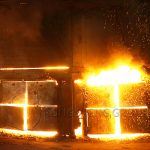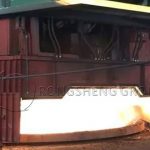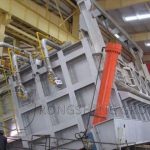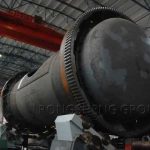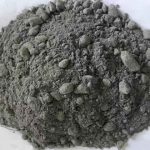There are many types of ferroalloys, and suitable furnace lining structures should be selected for the production of different ferroalloys. Several commonly used submerged arc furnace lining structure types.
(1) Insulation Type Furnace Lining
The traditional furnace lining structure used in submerged arc furnaces in my country is an insulation lining, as shown in Figure 1. This furnace lining structure has achieved good results in the long-term smelting process of various ferroalloys. The principle is to achieve a long-term heat insulation effect by improving the quality of refractory materials and increasing the thickness of refractory materials. The working layer of the thermal insulation furnace lining is mostly made of carbon bricks or magnesia bricks. In the ferroalloy smelting process, furnace bottom burnout is the most common production accident. Through the dissection of the submerged arc furnace, it was found that the furnace bottom burned through because the slag, metal melt, and reaction gas penetrated into the joints between the carbon bricks or magnesia bricks, thereby aggravating the damage rate of the furnace lining.
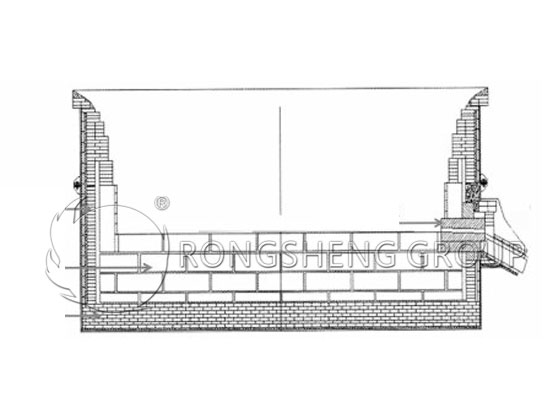
In order to solve the problem of joints between refractory bricks, Elkem proposed an integrally lined furnace lining structure. as shown in picture 2. Its working layer is made of amorphous refractory material (cold rammed paste) and is integrally pounded into shape, and then sintered into a whole body through an oven. In the 1990s, Elkem developed the world’s earliest cold ramming paste product, which showed excellent performance in Elkem submersible furnace tests and was adopted by many ferroalloy customers. At present, the overall lining is mostly made of carbon cold-pounded paste. It uses anthracite, graphite, etc. as aggregates, asphalt as binder, coal tar, resin, etc. as additives, and is mixed with a variety of materials. The physical and chemical properties of integral rammed lining are the same as those of carbon bricks. However, this integral structure can minimize the gaps between the carbon bricks, reduce the risk of furnace lining leakage and furnace bottom perforation, thereby effectively extending the life of the furnace lining. In order to solve the problem of poor oxidation resistance of carbonaceous materials, silicon carbide ramming materials have also been gradually developed. The antioxidant properties of the integral lining made of silicon carbide ramming material are greatly improved. At the same time, silicon carbide ramming materials use silica sol as a binding agent, which can form a large number of SiC whiskers in situ during high-temperature use, and the overall strength is significantly improved.
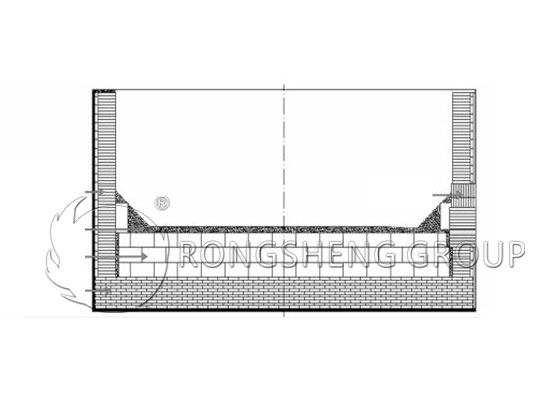
(2) Condensing Furnace Lining
As submerged arc furnaces become larger and larger, the smelting temperature becomes higher and higher, and the working conditions of furnace lining refractory materials become more and more demanding. It even reaches the physical and chemical performance limits of refractory materials. Simply increasing the thickness of the furnace lining and improving the quality of refractory materials can no longer meet the needs of modern smelting. In response to this problem, in 1995, SAMANCOR Company began research on the condensing furnace lining structure using a water cooling system and a high thermal conductivity carbon composite lining. In 1996, this condensing furnace lining structure was applied to ferromanganese production and achieved success. The concept of condensing furnace lining is completely different from that of traditional thermal insulation furnace lining. It uses high thermal conductivity refractory materials with thin masonry thickness. During use, it is combined with forced convection cooling of the furnace wall or furnace bottom. This design allows the slag to form a solidified shell on the inner wall of the furnace lining, so it has the function of “self-protection”. As shown in Figure 3. Compared with the insulating furnace lining, the structural characteristics of the condensing furnace lining give it the following advantages:
- ① The requirements for the performance of refractory materials are reduced, and the service life of the furnace lining is greatly extended. This reduces the economic losses caused by furnace building and furnace shutdown for maintenance, and significantly reduces the maintenance of the taphole.
- ② The thermal conductivity of the solidified shell formed by slag is small, which can effectively reduce energy loss caused by heat conduction and reduce unit power consumption.
- ③The thin lining of the condensing furnace lining increases the volume of the working area of the submerged arc furnace, which can increase the smelting output.
- ④ When constructing the lining of the condensing furnace, it is usually equipped with a thermocouple, which can monitor the furnace lining intrusion in real time to ensure production safety.
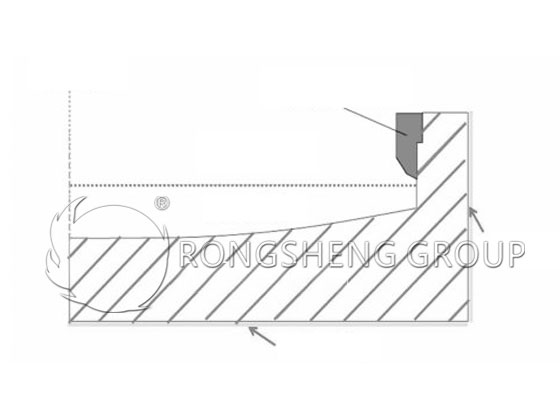
The cooling methods of condensing furnace lining mainly include copper cooling stave, furnace wall water cooling, and forced air cooling. Copper cooling staves have the best cooling effect. However, due to the cost of furnace construction, copper cooling staves have not been promoted on a large scale. The cooling effect of forced air cooling is not good, which will affect the formation of self-protecting furnace shell. At present, the condensing furnace lining mainly uses spray water for cooling. As a traditional standard cooling medium, water will cause the risk of explosion if leakage occurs during use, causing serious damage to the submerged arc furnace. Therefore, for safety reasons, the area cooled by spray water is limited to the outer area close to the steel shell and not close to the hot surface of the refractory material. The Austrian company Mettop GmbH has developed a new ionic liquid cooling technology. This ionic liquid is non-flammable, non-corrosive and non-toxic. And because of its lower vapor pressure, it can minimize the risk of explosion and has the trend and prospect of gradually replacing cooling water. With a deeper understanding of the condensing furnace lining, Elkem developed an improved condensing furnace lining, the structure of which is shown in Figure 4. characteristics of the structure. First, install forced air cooling on the outermost layer of the furnace wall and furnace bottom. Secondly, thicker carbonaceous cold ramming paste is used to pound the lower part of the furnace lining and the furnace bottom where the temperature is highest to form an integral lining. In addition, a silicon carbide ramming layer is laid under the carbon cold ramming paste, which not only prevents corrosive gases and metal melt from passing downward. And because of its higher thermal conductivity, it can also increase heat transfer outward and improve the condensation effect.
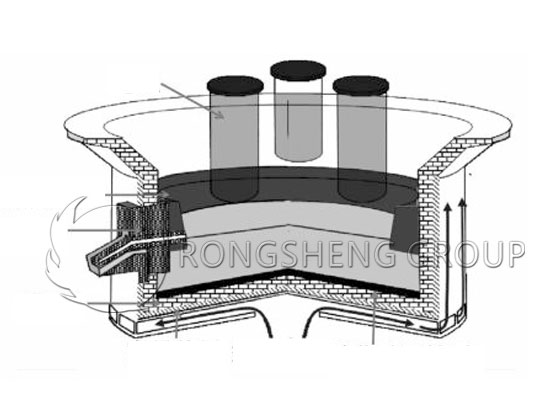
At present, condensing furnace linings are mainly used in submerged furnaces for alloy smelting such as manganese silicon, ferrochrome, ferronickel, ferromanganese, etc. Abroad, the Australian TEMCO Company has been using condensing furnace linings in ferromanganese and manganese silicon since 2001. As of 2017, the service life of the furnace lining has exceeded 15 years, and it has performed particularly well in extending the life of the taphole eyebricks. At present, although my country’s condensing furnace lining has more than ten years of industrial operation data, it has not yet been promoted on a large scale.
Regarding the use cost of condensing furnace lining and thermal insulation furnace lining. Through accounting for a high-carbon ferromanganese ore furnace of a certain enterprise, it was found that after the furnace lining was transformed from the insulation type to the condensation type, the economic benefit increased by an average of 14.83 million yuan per year during the three years of operation. Including benefits from reduced masonry costs, increased output, reduced power consumption and reduced coke consumption, and the annual income will further increase with the extension of the furnace lining life.
(3) Temperature-Controlled Furnace Lining
In view of the current situation where the overall damage to the furnace lining is mostly caused by the erosion of the furnace bottom by high-temperature molten iron, the Refractory Materials Company has designed a temperature-controlled furnace lining. Temperature-controlled furnace lining is a new furnace lining design concept, which was applied to a manganese-silicon alloy submerged furnace of a steel company in 2018. It adopts the design of furnace wall insulation + furnace bottom air cooling. Another company’s fully enclosed high-carbon ferromanganese ore furnace uses a temperature-controlled furnace lining structure, but it adopts a furnace wall water-cooling + furnace bottom air-cooling design structure. The main innovation of the temperature-controlled furnace lining is the furnace bottom air cooling system, which facilitates the rapid dissipation of heat from the furnace bottom lining and forms an “iron retention layer” on the furnace bottom to protect the furnace bottom. At present, both submersible furnaces of these two companies have achieved furnace lining temperature control. This industrial case opens up a new idea for long-life submerged arc furnace linings.
Get refractory lining solutions for free. Rongsheng Refractory Materials Manufacturer provides high-quality refractory lining products. Contact us to get free samples and quotes.



